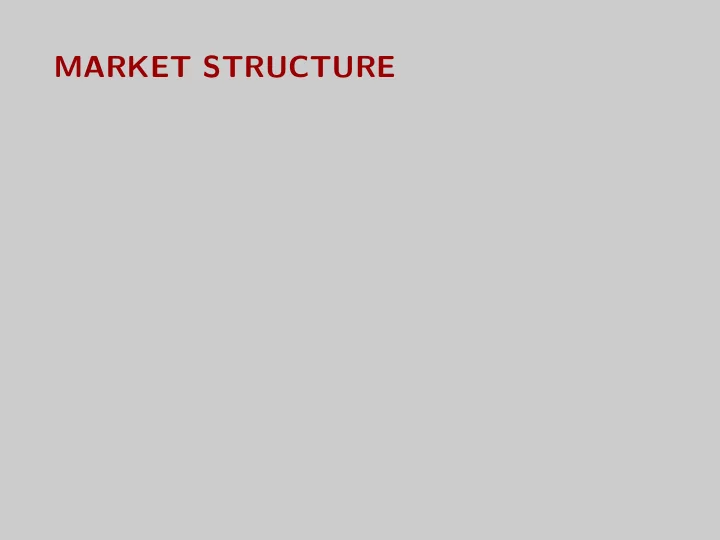

MARKET STRUCTURE
Overview • Context: You’re analyzing a given industry. How would you expect market structure to depend on type of industry, type of product, country size, etc • Concepts: exogenous and endogenous entry costs, scale economics and minimum efficient scale, business stealing • Economic principle: market structure depends on many factors, but there are some regularities
Industry concentration C4 (%) in Germany C4 (%) in Belgium 100 100 80 80 60 60 40 40 20 20 C4 (%) C4 (%) in France in France 0 0 0 20 40 60 80 100 0 20 40 60 80 100 C4 measures the combined market shares of the 4 largest firms. More on this later.
Market size and market structure • Cournot competition. Cost: C = F + c q i Demand Q = ( a − P ) S , where S is measure of market size � � 2 • Equilibrium profit level: a − c Π( n ) = S − F n +1 • Free entry equilibrium: Π( � n ) ≥ 0 ≥ Π( � n + 1) � S Π( � n ) = 0 n = ( a − c ) F − 1 ⇒ � � � S � n = ( a − c ) F − 1 where [ x ] denotes highest integer lower than x
Market size and market structure • Equilibrium value of n − increasing in a , S − decreasing in F , c • Relation between S and n is increasing but less than proportional • Intuition: higher S leads to higher n , but higher n leads to lower p , which in turn limits the increase in n
Market size and market structure n (number of entrants) 20 15 10 5 S (market size) 0 0 5 10 Parameter values: a = 100, c = 30, F = 100
Evolution of market structure • Number of firms and firm size changes over time: − firm growth − firm entry and exit − mergers and divestitures • Evolution determined by changes in − demand − technology − regulation
Production capacity of US brewers Capacity (10 3 barrels) 1959 1967 1975 1983 1989 1998 2001 2006 10 - 100 68 36 10 15 8 77 81 83 101 - 500 91 44 19 12 7 19 19 19 501 - 1000 30 35 13 2 3 1 1 4 1001 - 2000 18 18 13 13 5 4 2 2 2001 - 4000 8 10 12 9 6 7 5 3 4001+ 2 4 15 23 20 20 20 22 Source: Elzinga, in Adams and Brock
History matters • Same industry, similar countries, different market structures. Why? • Branding (e.g., Heinz and Campbell’s in UK and US) • Learning curves and other self-reinforcing processes • Multiple technologies and multiple free-entry equilibria
Evolution of new industries # firms in hard drive industry 30 active firms 20 10 entries exits Year 0 1975 1980 1985 1990 1995 2000 2005 2010 2015
Exogenous and endogenous entry costs • Compare Portugal ( S = 1) and the US ( S = 50) • Basic model predicts � � √ S US 50 S P n US ≈ ( a − c ) � − 1 ≈ ( a − c ) − 1 ≈ 50 � n P F F • This is about right in the cement industry • Beer industry: � n P = 2, whereas � n US = 3. Why does model fail?
Endogenous entry costs • Much of the entry cost into (national brand) beer is advertising • Advertising expenditures are roughly proportional to sales (when comparing various countries) • Hence, as S increases, so does F • In the limit, if F is proportional to S , then � n remains flat w.r.t. S . � � � � � � � � � S S 1 n = ( a − c ) F − 1 = ( a − c ) k S − 1 = ( a − c ) k − 1 � • Prediction: C 4 decreasing ( � n increasing) in S . However, relation is flatter in advertising-intensive industries
Advertising intensity Low-adv industries A/RS (%) High-adv industries A/RS (%) Salt 0.26–0.45 Frozen food 1.2–7.1 Sugar 0.06–0.24 Soup 2.7–6.0 Flour 0.17–0.96 Margarine 2.3–10.2 Bread 0.02–0.42 Soft drinks 1.2–5.4 Processed meat 0.30–0.70 RTE cereals 8.34–12.9 Canned vegetables 0.29–0.71 Mineral water 1.5–5.0 Sugar confectionery 1.4–6.0 Chocolate confectionery 2.9–6.5 R&G coffee 1.9–16.7 Instant coffee 2.2–11.1 Biscuits 1.9–8.0 Pet foods 4.0–8.4 Baby foods 0.9–4.2 Beer 1.0–5.43
Low- and high-advertising industries C4 (%) C4 (%) 100 100 50 50 ln(size/MES) ln(size/MES) 0 0 2 4 6 8 10 2 4 6 8 10 MES denotes minimum efficient scale. Used to compare market size across industries.
Recommend
More recommend